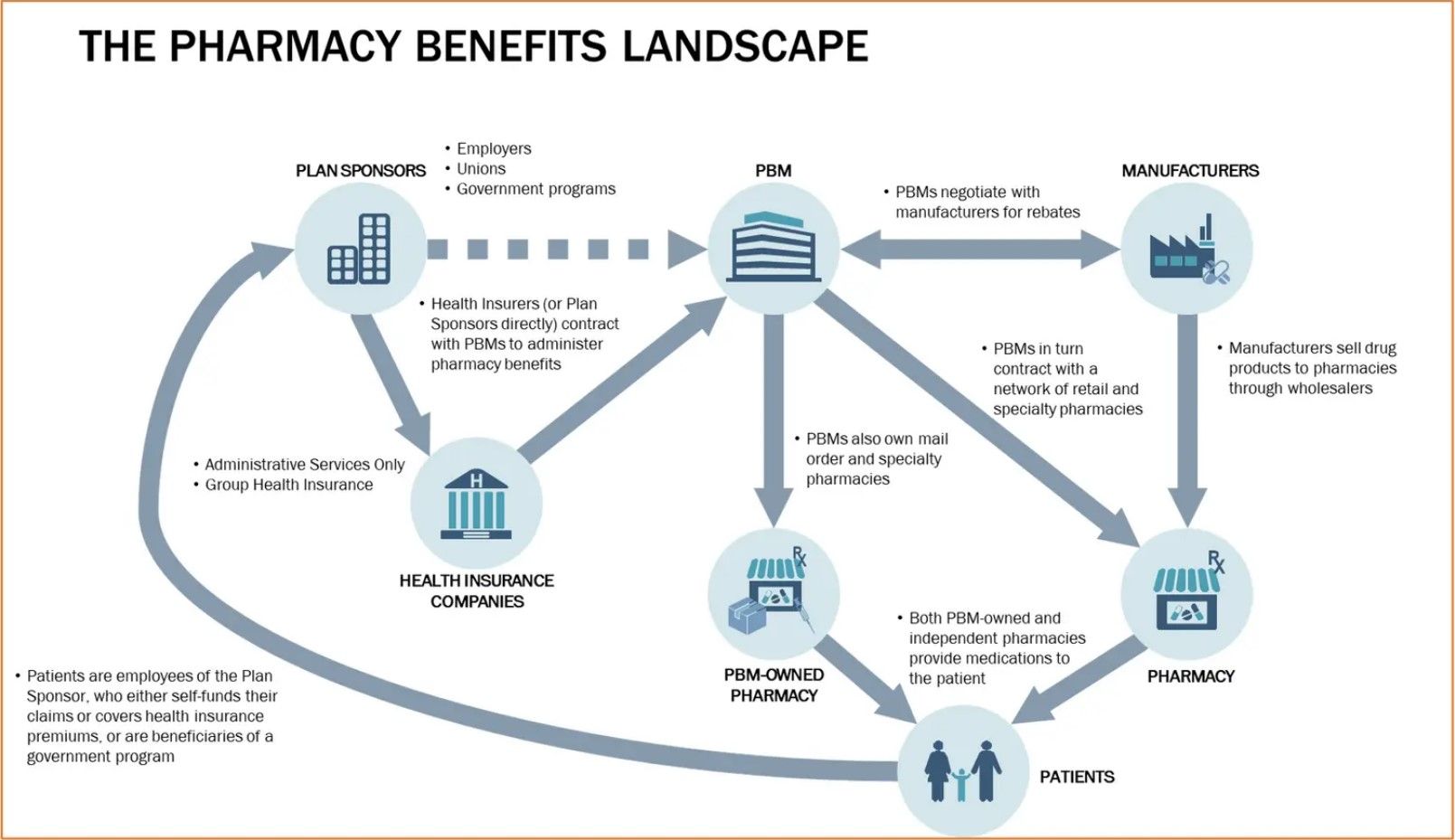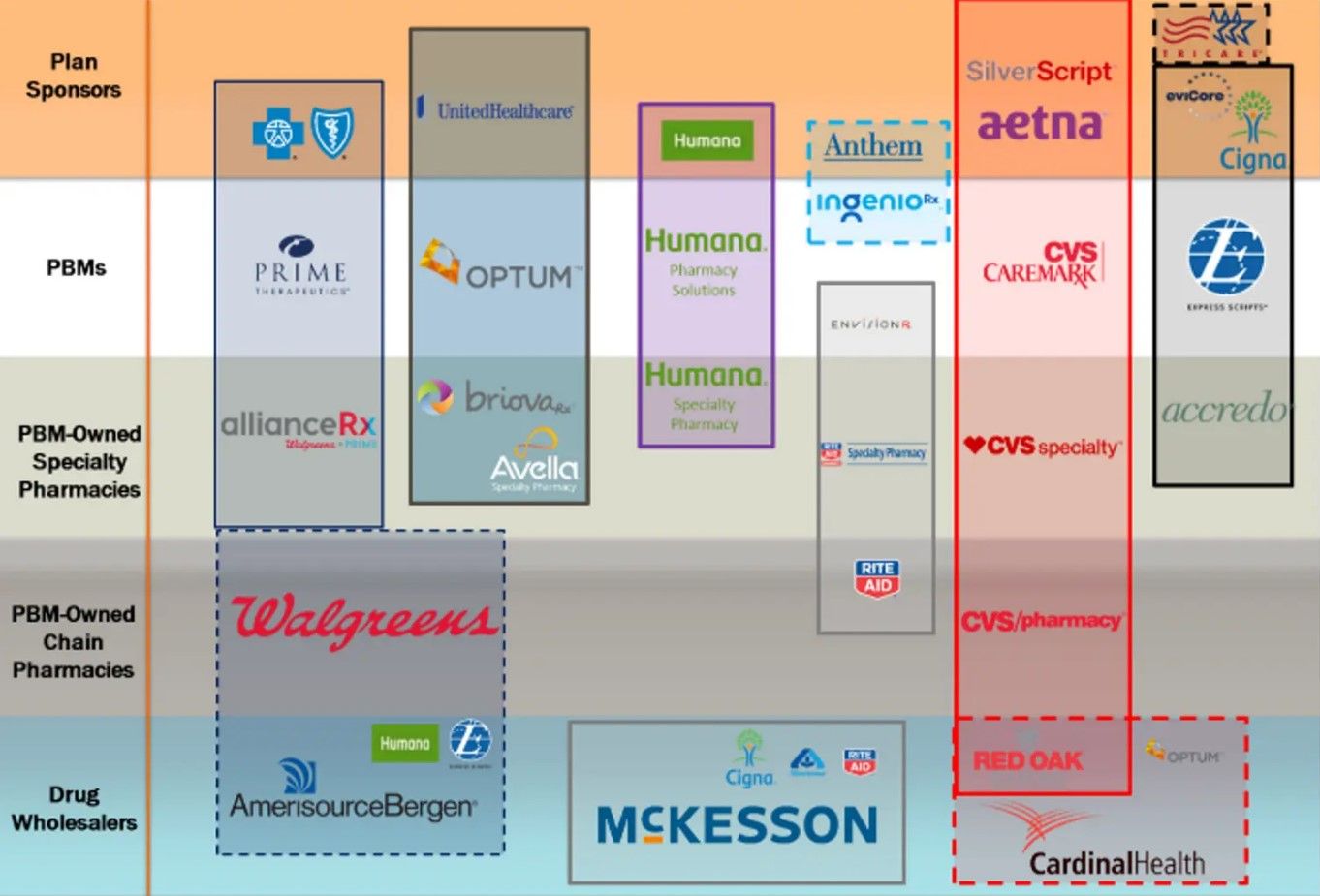Article
Considerations for Maintaining Payer Network Access in the World of Vertical Integration – Part 1: The Pharmacy Benefits Landscape
Author(s):
Vertical and horizontal consolidation has had a significant impact on retail, specialty, and health-system pharmacies.
Pharmacies of all types face exceptional challenges in seeking to maintain network access within a complex, yet ever-consolidating group of payers. With 3 companies currently enjoying more than 85% market share for prescription benefits coverage, the inability to participate in any one payer can be critical.
This is only made worse in the era of vertical integration, in which major pharmacy benefit managers (PBMs) serve not only as gatekeepers for pharmacies seeking access to the network, but also as direct competitors.
Through this 2-part article series, we explore both the current drug reimbursement landscape and consolidation and integration within the payer space, as well as abusive PBM practices and tools for providers to combat them. This first part of the series will focus on reimbursement and the landscape for drug products, and the impact that vertical and horizontal consolidation has had on retail, specialty, and health-system pharmacies.
Background of the Benefits and Reimbursement Landscape for Drug Products
The current system of coverage and reimbursement for drug products within the United States might seem alien, even to those providers steeped in the health care industry. The costs, extent of coverage, reimbursement rates, out-of-pocket amounts and applicable rights may differ wildly depending on many factors, including the type of drug, the route of administration, the place of service and the site of care.
In order to sift through this morass, it is helpful to begin by understanding who the relevant stakeholders are, as well as their roles in benefits design and the provision of care.
The first relevant stakeholder is the plan sponsor. Plan sponsors are the ultimate financial guarantors and decisionmakers when it comes to creating a health care benefits plan.
Plan sponsors include a variety of public programs, such as Medicare, Medicaid, and TRICARE programs, as well as private entities, including employers, union groups, and retirement funds. Plan sponsors, in turn, contract with several other entities for the purposes of administering the plan.
Among the entities contracted by plan sponsors are health insurance companies.* Health Insurance Companies manage healthcare claims submitted by providers for care provided to patients who are employees, beneficiaries and/or members of the plan, or their dependents.
Health insurance companies typically contract with plan sponsors on either a fully insured basis (in which the health insurance company bears full financial risk) or an “administrative services only” basis (in which the plan sponsor remains self-insured and the health insurance company bears no financial risk).
Health insurance companies typically manage a medical benefit (discussed below) and reimburse claims for major medical expenses (i.e., physician visits, surgical procedures, hospital stays, etc).
Likewise, plan sponsors contract with PBMs—either directly or through a health insurance company—to manage the pharmacy benefits. PBMs are responsible for negotiating with a network of pharmacy providers and reimbursing for drug claims submitted on behalf of plan members.
PBMs also negotiate with drug manufacturers seeking rebate payments in exchange for preferential formulary placement. Among the pharmacy providers contracted by PBMs are independent pharmacy providers, chain pharmacies, specialty pharmacies, infusion pharmacies, and hospital and health system pharmacies.
However, also included with PBM networks are pharmacies owned by or affiliated with the PBMs. This relationship creates odd incentives for PBMs, acting not only as gatekeepers to the network of contracted pharmacies for a given plan, but also as a direct competitor to those very same pharmacies.
The chart below illustrates the various stakeholders, their roles, and their relationships to one another.

The roles, rights, and responsibilities of these various stakeholders are directly impacted by the type of benefit involved. As noted above, there are essentially 2 relevant benefits: the medical benefit and the pharmacy benefit.
Medical benefits are generally administered by health insurance companies directly, by which providers submit claims to the health insurance company directly, or in the case of Medicare claims, to Medicare Part B through a Medicare administrative contractor (MAC).
While medical benefits generally include traditional medical services (physician visits, hospital admissions, etc), they may often include various forms of coverage for drugs. For example, when they are administered in-office or dispensed to the patient for infusion at home.
The types of medications more commonly reimbursed under a medical benefit include certain specialty medications, total parenteral nutrition, infused medications, insulin, and other medicines that are not typically self-administered.
When submitting drug claims to medical benefits, providers typically submit using J-codes or Q-codes for the medication as opposed to an NDC number. They may also be able to submit certain CPT codes associated with procedures or ancillary supplies that go along with filling the medication. When reimbursed under a medical benefit, drugs are typically paid out based either on wholesaler acquisition cost or average sales price, especially when being submitted to Medicare Part B.
Pharmacy benefits, meanwhile, are adjudicated and reimbursed by PBMs. The plan sponsor—which could be a commercial payer, Medicare Part D prescription drug plan PDP, or Medicare Advantage Prescription drug plan—will require that all pharmacy claims be submitted electronically to the designated PBM.
Unlike medical claims that may require paper billing and retrospective claims approval, pharmacy claims are adjudicated in real time at the point-of-sale using the current version of NCPDP claims submission protocol. Pharmacy claims are typically reimbursed as a function of a contracted discount off of average wholesale price, although they may also be paid based on maximum allowable cost, average acquisition cost, or the provider’s usual and customary retail price, whichever is lower.
Consolidation and Vertical Integration in the Payer Space
In the years following the creation of the Medicare Part D Drug Program, there has been an unprecedented level of consolidation and vertical integration in the drug delivery channel. Beginning in 2007, retail pharmacy giant CVS became the first chain pharmacy to be integrated with a PBM when it merged with Caremark Rx and became CVS/Caremark.
In response, the PBM industry underwent a slew of horizontal mergers, starting with Express Scripts, Inc, which acquired Medco Health Solutions in 2012 for $29.1 billion. OptumRx, the PBM subsidiary of UnitedHealth, continued this trend with its 2015 acquisition of Catamaran Corp, which was the product of a 2012 merger between SXC Health Solutions Corp and Catalyst Health Solutions, Inc.
Such consolidation in the PBM space saw the marketplace dramatically concentrate, going from 9 significant PBM players in 2011, to 6 in 2017, 3 of which controlled more than 70% of the marketplace at the time—Express Scripts, CVS, and OptumRx.
With an already heavily concentrated PBM marketplace, particularly at the top, these large conglomerates, many of whom were already Fortune 100 companies embarked on a new form of vertical integration. Prior to 2017, UnitedHealth with its wholly owned OptumRx, was the only vertically integrated PBM-health insurer; however, in December 2017, CVS/Caremark announced its intent to acquire Aetna for $69 billion.
Not to be outdone, in March 2018, Cigna and Express Scripts announced a $67 billion merger of their own. Despite some speculation that the Federal Trade Commission or Department of Justice would move to block the mergers, both were approved in late 2018.
Even during an era in which the 3 largest PBMs own or are owned by some of the nation’s largest health insurers, consolidation continues. In 2018, OptumRx purchased Avella Specialty Pharmacy, one of the country’s largest independent specialty pharmacies, and in December 2019, announced the acquisition of Diplomat Pharmacy, a publicly traded specialty pharmacy-PBM combination.
These acquisitions give OptumRx a unique advantage in the specialty pharmacy marketplace, particularly with respect to key limited distribution drugs. Finally, in late-2019, Prime Therapeutics announced a 3-year collaboration agreement with Express Scripts, where it moved its commercial and managed Medicaid plans to Express Scripts.
In all, and as noted in the below graphic, we now have an extremely consolidated and concentrated landscape, with virtually every player in the market having near complete vertical integration, from plan sponsor, to PBM, to specialty pharmacy, to wholesaler.

Impact on Pharmacy Providers
Through the rapid evolution of the PBM and health insurance industry, a limited number of corporations wield an outsized level of control and influence in the prescription drug coverage marketplace. Fewer payers exponentially increases the importance of network access for providers. Exclusion from a PBM with a market share of 35% means that the provider loses out on a major portion of the patient population.
Recognizing this, integrated PBMs have embarked on a variety of tactics that are nothing short of abusive toward retail, specialty, and health-system pharmacies alike. These include offering below-water reimbursement rates, clawing back onerous direct and indirect remuneration fees, engaging in byzantine generic effective rate (reconciliations, prescription trolling/patient slamming, and the creation of restrictive payer networks.
These tactics—and the tools available to fight them—will be described in further detail in part 2 of this article series.
Conclusion
The immense vertical and horizontal consolidation among payers has had an immeasurable effect on pharmacy providers of all kinds. Just 3 payers—each of which owns their own pharmacy—control nearly 85% of the pharmacy benefits marketplace. Pharmacy providers need an effective strategy to maintain leverage against this imbalance of power.
* While referred to under the umbrella of health insurance companies, these entities could also take the form of health maintenance organizations, preferred provider organizations, medical service corporations, hospital service corporations, and/or health service corporations, depending on the type of plan.
About the Author
Jesse C. Dresser, Esq, is a partner in Frier Levitt’s Life Sciences Department and heads the firm’s Pharmacy Practice Group.






